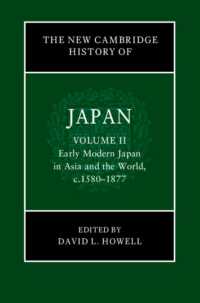- ホーム
- > 洋書
- > 英文書
- > Science / Mathematics
Full Description
This book presents two candidates for astrophysical accelerators of cosmic rays with petaelectron-volt (PeV) energies in our Galaxy, the so-called PeVatrons, through the observation of sub-PeV gamma rays performed by the Tibet air shower array. The two gamma-ray sources are TASG J1844-038—a newly detected source in this presented work—and HESS J1849-000. Reconstructing their gamma-ray energy spectra up to the sub-PeV range and also analyzing the archive data published by a radio survey, the book discusses in depth the emission mechanisms of the observed gamma rays and suggests that these two gamma-ray sources are candidates for PeVatrons. The results give insights into the population of PeVatron in the Galaxy, which is important to consider their contribution to the PeV cosmic rays observed at the Earth.
Contents
Introduction (introduction of the history of cosmic-ray physics and sub-PeV gamma-ray astronomy to present the motivation of our study).- Tibet air shower array and the muon detector array (explanation of the instrument that we use).- Data analysis (explanation of the data analysis process).- Result 1: Detection of a new gamma-ray source TASG J1844-038 in the HESS J1843-033 region (results of the data analysis and the discussion).- Result 2: Observation of gamma rays from HESS J1849-000 (results of the data analysis and the discussion).


















